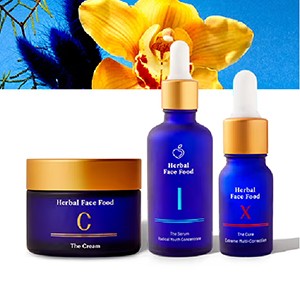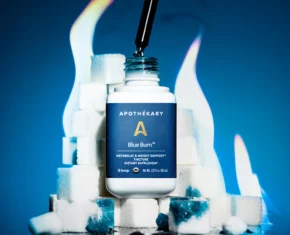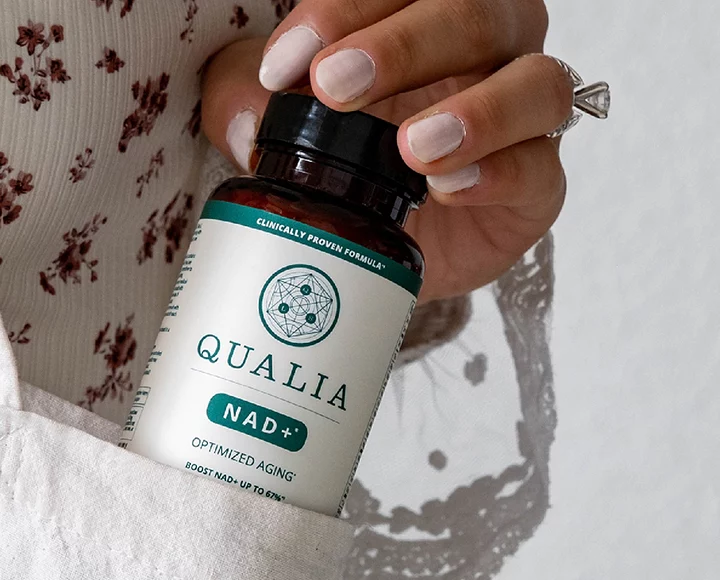Did your bad skin day turn into a bad skin week, despite your attempts to keep your complexion calm and contained? Hormonal fluctuations might be at the heart of it. We asked LA-based holistic aesthetician, Hayley Wood aka Therapeutic Skin Coach, to talk to us about how to manage skincare when our hormonal cycles are wreaking havoc. From understanding the four major phases our bodies experience each month to ultra-soothing products to get you back to a balanced state…
There are many phrases in both the skincare and beauty industry that we’ve heard over and over again — phrases and ideas that we are conditioned to believe. Even to the point that we may not realize a trend’s true meaning. The most popular phrase that comes to mind? Anti-aging. So, are we meant to age backward? Or not age at all? And the problem is that holistic facialists like myself need to continuously re-educate clients on proper definitions.
Are hormones and skin connected?
One of the most common conversations I have with new clients is about hormonal cycles. Most often it’s how to detach misconceptions around the phrase hormonal skin condition. Think about it: We are all hormonal. We all have a hormonal reproductive system and an endocrine system. An ever-changing environment, daily product use and irregular food consumption may all lead to constant hormonal fluctuation.
However, blanketing all skin conditions with the term hormonal feels a little misleading. The majority of us are not connected with the true functions in our systems. Thus doing so can also be dismissive of the real messaging our skin is communicating with us — especially when experiencing a skin imbalance. Our skin is extremely responsive to our hormones. It is the first to reflect a hormonal imbalance and the happiest when hormones are in balance.
How does my hormone cycle affect skin health?
I want to talk about how I teach my female clients to better understand their hormone cycle and how it correlates to skin health. This mindful teaching is not one that I’ve always felt eloquent in. But since I began skincare work in 2006, it’s one that I’ve been forced to pay attention to. There is a huge gap in our general knowledge on how to become more in-tune with monthly cycles.
Many clients experience conditions such as PCOS, endometriosis, infertility and irregular periods, so it became clear to me that the least I can do is help women understand the skin’s response to imbalance. It isn’t punishment for being a woman, but rather an important communication tool indicating how to support overall health.
My collaboration with Sonäge Skincare and their Fertility Facial is so much more than just a trendy new facial. It is an opportunity for women to better understand their cycles while finding harmony with their hormones. The Sonäge Fertility Facial emphasizes the importance of preventative measures to maintain a strengthened immunity. I don’t want your skin working overtime. I want to see self-care, rest, mindful nutrition, stress-management, self-compassion and choosing ingredients that are safe for long-term health.
It’s important to acknowledge that we are constantly evolving. Our bodies naturally experience slight daily shifts during our 28-31 day hormone cycle. And, we also shift seasonally as the environment changes. Eventually, our cells renew completely every seven or so years. Hence, nothing is permanent. This can feel like a relief when your immunity, or even your self-esteem, lowers. This is good news! There is always an opportunity to start implementing new holistic health habits so that your future self can enjoy the long-term benefits.
Tell me more about my hormone cycle…In order to break down the basics of our menstrual cycle, it’s important to look at the four phases we have and the importance of each one.
The follicular phase starts on the first day of menstruation (yes, you’re in two of your phases at once for at least four to five days). During this phase, the pituitary gland communicates to specific hormones to start producing egg cells in the ovaries again. The follicular phase is often 13 days long and rebuilds energy levels after shedding the uterine lining. For the most part, women don’t seem to experience too much of a fluctuation in their skin during this time unless they are incredibly depleted in certain vitamins and minerals, or have not been experiencing a lot of PMS symptoms caused by excess stress.
This is often the result of excess cortisol, adrenal fatigue and/or even thyroid imbalance if stress isn’t managed daily. The results of these imbalances also have a more lasting effect on the skin, which may be classified as a hormonal imbalance. But skin is often not fixed solely with birth control or topical care. This work is a little deeper to dive into, but once it’s addressed, the skin does a great job responding accordingly. Typically, the follicular phase is one in which we start to feel better and more energized, so our skin reflects this shift beautifully.
The number one takeaway of this stage is to help the skin feel supported. We can do this by adding vitamin-rich and hydrating ingredients that encourage the skin’s natural ability to regenerate. I suggest the Sonage High Impact Vitamin C serum, Laurel Whole Plant Organics Antioxidant Serum or Odacite’s Blueberry Jasmine Serum. Over-treating skin with harsh actives (such as AHAs and retinol) could deplete your skin more. In other words, think about feeding your skin instead of stripping it.
The ovulation phase starts once your menstrual and follicular phases are over. This is often the fourteenth day of your cycle. The now mature egg cell is prepared to be released from the ovary to the fallopian tube. Once the pituitary gland communicates this function, the body will secrete the hormone needed for ovulation. This is also the opportunity to conceive or the signal to avoid intercourse. Most standard birth control pills are created to trick the body into skipping this step to prevent pregnancy. At this time the body tends to peak in hormone levels, as well temperature, which can be associated with breakouts during the next phase of our cycle.
On a skin level, the reason you may experience imbalance is because of actions taken in this stage — eating non-supportive foods, overextending without proper stress management, ignoring the overall body temperature or little-to-no rest/reset time. All of these habits can trigger overcompensation by our skin for detoxification. It will work on one or more of its primary functions as a filter to shed excess waste, a barrier to protect from environmental triggers and regulation of body temperature. The skin will start to feel stressed when working on all of these functions at once.
The ovulation phase is not always when we can physically see an imbalance, but it is the perfect time to set yourself up for skin success. Take preventative action to avoid skin stress. Add a gentle, calming mask to your routine that will balance the primary functions of your skin. I recommend the Sonage Tulsi Soothing Tri Clay Mask or the MV Skincare Signature Mineral Mask. Or, if you tend to become excessively oily and are prone to congestion, the Sonage Pom Crush Detox Mask is a great way to naturally break down the excess build-up so your skin doesn’t overdo it.
The luteal phase starts right after ovulation and is typically when many feel the most intense skin shift. Hormone levels peak and immediately drop to help prepare the shedding of the uterine lining if conception didn’t take place. Along with monitoring overall nutrition to make sure the body feels supported during this stage, it is also a time when brain activity can feel sluggish. The need for an afternoon nap may feel exceptionally strong.
Because we don’t live in a culture where our schedules are designed to optimize time and focus per phase of our menstrual cycle, it can feel like we are all overcompensating. We opt for the quick fix to help us stay alert and present. This can mean more caffeine or an increase in stimulating foods. If the body is feeling slow or sluggish, this can mean that our overall system needs more rest.
The best piece of advice I give my clients is to try to get more rest. Otherwise skin cells may deplete from their overall radiance. Go to bed early. Avoid excess blue light which can trigger hyperpigmentation. If our hormones are not supported (since all of our cells have different circadian rhythms) when we’re pushing ourselves too much, add hydration to your cells. This can help your overall appearance and energy. I recommend Sonage NMF hyaluronic serum, Osea Malibu’s Hyaluronic Sea serum or a fatty acid rich product like the De Mamiel Pregnancy Oil. These could be the perfect addition to your daily routine to rejuvenate tired skin.
What can I do during menstruation to support skin health?
During menstruation, it’s really valuable to simplify your care and allow your skin to do what it does best: self heal. I suggest a simple rinse solution like the Josh Rosebrook Hydrating Accelerator (which is rich in aloe, healing herbs and natural astringents like lavender and witch hazel). It will help balance the skin during menstruation. Using this product indicates to the skin that you trust its functions and gives it the space to reset.
What is most important during all the cycle phases is to make sure you are connecting your whole body. The primary reason we experience skin imbalance directly connects to a blockage in the lymphatic system. The lymphatic system is essential for eliminating excess dermal waste and stagnant proteins in the skin. If this system is blocked due to stress, tension or a lowered immunity in our body, it will cause build-up or blockages on the skin. This will present in the form of breakouts, wrinkles, inflammation or even hyperpigmentation. A good practice of at-home gua sha and overall lymphatic system support (like a rebounder routine and/or dry brushing) will make a big difference for glowing and vibrant skin throughout each phase of your cycle.
What about holistic skin and cycle care?
So many of my clients love the concept of cycle syncing skincare, but they’re often discouraged if they experience irregular or absent cycles. This is when I encourage outside resources to support an individual’s case. As frustrating as a blemished face can feel, it’s often the last of your worries if hormones are needing deeper support. Connecting with an acupuncturist, naturopath and/or a holistic nutritionist can help nourish areas of your system that need the most support. A holistic esthetician can encourage the lymphatic system to eliminate excess waste. This will all help the skin come back to its optimal potential for radiance.
Once you feel supported and begin to recognize your cycle phases, as well as how it often fluctuates, you should feel empowered to navigate some of the most intense and beautiful hormonal transitions in life, such as pregnancy and post-natal. This is also why conscious skincare companies, like Sonage Skincare, have created pregnancy safe and immunity supporting facials to help you feel encouraged during this process.
At the end of the day, all your skin is doing is evolving with you throughout the cycles and seasons of life. An appreciation of how your skin communicates with you will help you navigate all those changes through the lens of love. Choose the right self-care routine to best support you.












